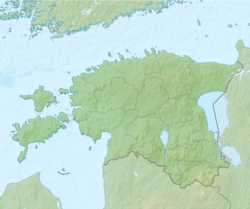
Back كيهنو ARZ Kihnu adası Azerbaijani Кихну Bashkir Кіхну Byelorussian Кіхну BE-X-OLD Kihnu CEB Kihnu Czech Кихну CV Kihnu Danish Kihnu DAG
This article needs additional citations for verification. (May 2023) |
Kihnu
Kihnu Kynö | |
|---|---|
Island | |
 Gulf of Riga, with Kihnu and other islands | |
| Coordinates: 58°07′48″N 23°59′24″E / 58.13000°N 23.99000°E | |
| Country | |
| Region | Pärnu County |
| Municipality | Kihnu Parish |
| Area | |
| • Total | 16.38 km2 (6.32 sq mi) |
| Elevation | 29.6 m (97.1 ft) |
| Population (2013) | |
| • Total | 690 |
| • Density | 42/km2 (110/sq mi) |
| Time zone | UTC+2 (EET) |
| • Summer (DST) | UTC+3 (EEST) |
| Postal codes | 88005 |
Kihnu is an island in the Baltic Sea. With an area of 16.4 km2 (6.3 sq mi), it is the largest island in the Gulf of Riga[2] and the seventh largest island of Estonia. With a length of 7 km (4.3 mi) and width of 3.3 km (2.1 mi), the island's highest point is 8.9 metres (29.2 ft) above sea level.
Kihnu falls into Pärnu County and together with neighbouring islands forms Kihnu Parish, one of the smallest municipalities of the country, with an area of 16.8 km2 (6.5 sq mi).
604 people lived on Kihnu as of 2007[update], 69 of whom were primary school pupils. There are four villages: Lemsi, Linaküla, Rootsiküla, and Sääre. One can reach Kihnu by a fifteen-minute plane trip from Pärnu or by ferry, with trips taking three hours from Pärnu and one from Manilaid. When the sea is frozen in winter, it is possible to drive to the island over the ice.
The nearby isle of Manilaid (or Manija, Manõja in the Kihnu dialect) has been inhabited by people from Kihnu since 1933 and thus shares its culture.
UNESCO proclaimed Kihnu's cultural space and traditions as a Masterpiece of the Oral and Intangible Heritage of Humanity on 7 November 2003.[3][4]
Kihnu is also called Kihnumua in the local dialect. Names in other languages include Ķīļu in Latvian, Kynö in Standard Swedish, Kin in Estonian Swedish, and historically, Kühnö in German. In Estonian Sign Language, the island is signed by imitating the vertical stripes of a Kihnu skirt. There are various theories on the etymology of the name Kihnu, with no consensus. The earliest recorded version of the name is Kyne, from 1386.[5]
- ^ Cite error: The named reference
estonicawas invoked but never defined (see the help page). - ^ C.Michael Hogan. 2011. Gulf of Riga. Encyclopedia of Earth. Eds. P.Saundry & C.J.Cleveland. National Council for Science and the Environment. Washington DC.
- ^ "Kihnu cultural space – intangible heritage". UNESCO.
- ^ "Beyond Tallinn: Stunning Places to Visit in Estonia You Never Knew Existed – Europe Guidebook". 4 February 2023. Retrieved 7 April 2023.
- ^ Dictionary of Estonian Place names.


